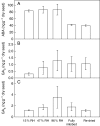Prior hydration of Brassica tournefortii seeds reduces the stimulatory effect of karrikinolide on germination and increases seed sensitivity to abscisic acid
- PMID: 20348089
- PMCID: PMC2876004
- DOI: 10.1093/aob/mcq061
Prior hydration of Brassica tournefortii seeds reduces the stimulatory effect of karrikinolide on germination and increases seed sensitivity to abscisic acid
Abstract
Background and aims: The smoke-derived compound karrikinolide (KAR(1)) shows significant potential as a trigger for the synchronous germination of seeds in a variety of plant-management contexts, from weed seeds in paddocks, to native seeds when restoring degraded lands. Understanding how KAR(1) interacts with seed physiology is a necessary precursor to the development of the compound as an efficient and effective management tool. This study tested the ability of KAR(1) to stimulate germination of seeds of the global agronomic weed Brassica tournefortii, at different hydration states, to gain insight into how the timing of KAR(1) applications in the field should be managed relative to rain events.
Methods: Seeds of B. tournefortii were brought to five different hydration states [equilibrated at 15 % relative humidity (RH), 47 % RH, 96 % RH, fully imbibed, or re-dried to 15 % RH following maximum imbibition] then exposed to 1 nm or 1 microm KAR(1) for one of five durations (3 min, 1 h, 24 h, 14 d or no exposure).
Key results: Dry seeds with no history of imbibition were the most sensitive to KAR(1); sensitivity was lower in seeds that were fully imbibed or fully imbibed then re-dried. In addition, reduced sensitivity to KAR(1) was associated with an increased sensitivity to exogenously applied abscisic acid (ABA).
Conclusions: Seed water content and history of imbibition were found to significantly influence whether seeds germinate in response to KAR(1). To optimize the germination response of seeds, KAR(1) should be applied to dry seeds, when sensitivity to ABA is minimized.
Figures





Similar articles
-
Parental environment changes the dormancy state and karrikinolide response of Brassica tournefortii seeds.Ann Bot. 2012 Jun;109(7):1369-78. doi: 10.1093/aob/mcs067. Epub 2012 Apr 3. Ann Bot. 2012. PMID: 22492259 Free PMC article.
-
Seeds of Brassicaceae weeds have an inherent or inducible response to the germination stimulant karrikinolide.Ann Bot. 2011 Oct;108(5):933-44. doi: 10.1093/aob/mcr198. Epub 2011 Aug 5. Ann Bot. 2011. PMID: 21821831 Free PMC article.
-
Karrikins delay soybean seed germination by mediating abscisic acid and gibberellin biogenesis under shaded conditions.Sci Rep. 2016 Feb 23;6:22073. doi: 10.1038/srep22073. Sci Rep. 2016. PMID: 26902640 Free PMC article.
-
First off the mark: early seed germination.J Exp Bot. 2011 Jun;62(10):3289-309. doi: 10.1093/jxb/err030. Epub 2011 Mar 23. J Exp Bot. 2011. PMID: 21430292 Review.
-
Plant-Derived Smoke Affects Biochemical Mechanism on Plant Growth and Seed Germination.Int J Mol Sci. 2020 Oct 20;21(20):7760. doi: 10.3390/ijms21207760. Int J Mol Sci. 2020. PMID: 33092218 Free PMC article. Review.
Cited by
-
Smoke produced from plants waste material elicits growth of wheat (Triticum aestivum L.) by improving morphological, physiological and biochemical activity.Biotechnol Rep (Amst). 2017 Dec 13;17:35-44. doi: 10.1016/j.btre.2017.12.001. eCollection 2018 Mar. Biotechnol Rep (Amst). 2017. PMID: 29270367 Free PMC article.
-
Morphological and physiological characteristics of seeds and their capacity to germinate and survive.Ann Bot. 2010 Jun;105(6):975-6. doi: 10.1093/aob/mcq107. Ann Bot. 2010. PMID: 20501881 Free PMC article. No abstract available.
-
Parental environment changes the dormancy state and karrikinolide response of Brassica tournefortii seeds.Ann Bot. 2012 Jun;109(7):1369-78. doi: 10.1093/aob/mcs067. Epub 2012 Apr 3. Ann Bot. 2012. PMID: 22492259 Free PMC article.
-
Seeds of Brassicaceae weeds have an inherent or inducible response to the germination stimulant karrikinolide.Ann Bot. 2011 Oct;108(5):933-44. doi: 10.1093/aob/mcr198. Epub 2011 Aug 5. Ann Bot. 2011. PMID: 21821831 Free PMC article.
-
Seed dormancy regulates germination response to smoke and temperature in a rhizomatous evergreen perennial.AoB Plants. 2018 Jul 4;10(4):ply042. doi: 10.1093/aobpla/ply042. eCollection 2018 Aug. AoB Plants. 2018. PMID: 30057736 Free PMC article.
References
-
- Ali-Rachedi S, Bouinot D, Wagner MH, et al. Changes in endogenous abscisic acid levels during dormancy release and maintenance of mature seeds: studies with the Cape Verde Islands ecotype, the dormant model of Arabidopsis thaliana. Planta. 2004;219:479–488. - PubMed
-
- Bradford KJ. Water relations in seed germination. In: Kigel J, Galili G, editors. Seed development and germination. New York: Marcel Dekker; 1995. pp. 351–396.

